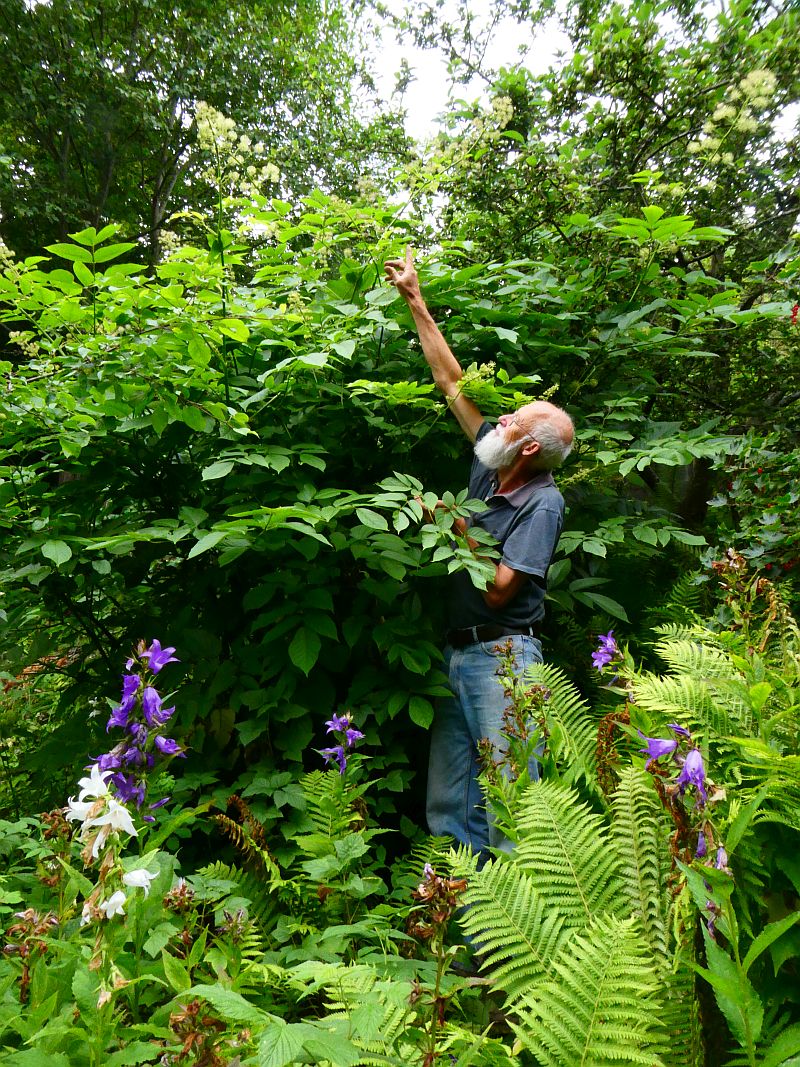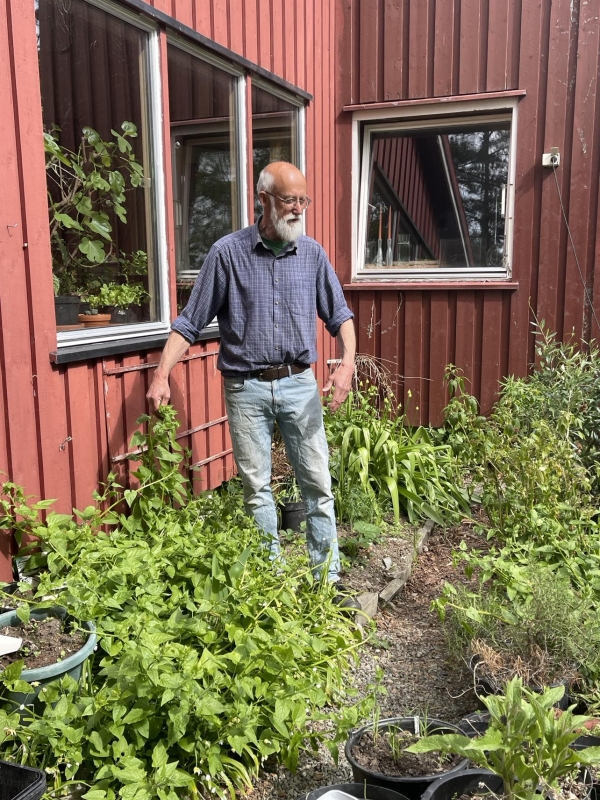During a powerful wind storm earlier in the year one of my oldest sallow / selje trees on the edge of the wild part of the garden was wind thrown and fell over the part of my garden most resembling a forest garden where my impressive 20-year old udo (Aralia cordata) is located. Luckily, it did no damage to my apple trees and the trunk is hanging horizontally over this area with part of the root still attached and what was the top of the tree now in full flower right next to the pathway down the garden. Salix caprea is dioecious with male and female flowers on separate trees. This one is female. I have over the years become more and more aware of the incredible importance of Salix caprea in providing food in early spring to a myriad of insects – wild bees, bumble bees, moths etc., all programmed to emerge at this time. In addition, it is host in Norway to 260 moth and butterfly species at the larval stage! This then leads to this tree being an important source of food to a range of birds and some like the chiffchaff (gransanger) are also programmed to return at sallow flowering time. During visits to my mum in Southern England in March / early April I visit other fallen sallows to look for interesting insects and I’ve noticed that they can continue flowering for several years after falling and resprout from the part of the root in the soil. So, although I was initially saddened bye the loss, this is just one of several large sallow trees in this part of the garden and now I have the top of a sallow at eye level right next to a path in the garden and can now study visiting insects closely. Just now, I saw an early bumblebee / markhumle (Bombus pratorum) feeding on the catkins. It’s also a perfect place to hang my moth trap (picture)!
Hence “A blessing in disguise” (Norwegian: hell i uhell).
See also https://www.edimentals.com/blog/?p=32035
Tag Archives: Forest Garden
First Chestnut



North American Forest Garden
On the Eastern boundary at the Væres Venner community garden in Trondheim, I wanted to develop a small forest garden devoted to edible plants of the first peoples in North America. Two years ago I planted two of them which now have berries for the first time!
They are
a) Purple flowering raspberry / rosebær (Rubus odoratus), a species which is often planted as an ornamental in Norway, usually a single clone so most are not aware that is has tasty fruit. With this in mind I germinated seed from the NARGS seed list, sown in January 2022 which germinated late May the same year and were planted out in May 2023, so just two years from seed to the first berries.
b) Black hawthorn / Douglashagtorn (Crataegus douglasii): this is given 4 out of 5 stars at https://pfaf.org/User/plant.aspx… and after my first taste I agree with their assessment: they would make a good addition to a mixed fruit salad. No wonder this berry was widely used by native americans including the Cheyenne.
I now plan to prepare the area around the trees for perennial vegetables from the same area!
The first Udo photo shoot for 2024
Despite the record warm May here at 63.4N with temperatures up to 30C and drought like conditions (forest fire warnings on the news every day), my now 23 year old udo (Aralia cordata) has grown away well, but perhaps not as vigorous as normal in cooler damper conditions which are the norm for May. Sadly, my California-udo (Aralia californica) which was in a much drier location seems to have died, although I have a clone in the World Garden at the Væres Venner Community Garden.
Thanks to KVANN member Nina Sandli who took the picture on a visit on 25th May!
More about my super vegetable in many blog posts, see https://www.edimentals.com/blog/?s=udo
or read about it in my book Around the World in 80 plants!
The 2023 Permaveggies / Forest Gardening course
The 5th Permaveggies / Forest Gardening course I’ve held in Malvik took place on Sunday 21st and Monday 22nd May with guest Jen McConachie who gave her forest gardening course at Presthus Farm on the Monday evening. On the Sunday we met at my garden (The Edible Garden) for a garden tour and lunch from the garden with focus this year on growing food while maintaining a high biodiversity. On Monday we visited The Væres Venner Community garden to see the World Garden and also the large collection of edible trees and bushes that have been planted there, followed by a visit to the Onion Garden at the Ringve Botanical Garden in Trondheim.
Previous Permaveggies weekends were held in 2012, 2013, 2016 and 2019 whilst the 2020-weekend had to be cancelled because of Covid. More information on previous courses can be found here: Previous Permaveggies Courses.
I didn’t take many pictures this year, so thanks to Meg Anderson, Jen McConachie and Mark Tacker who took the pictures below.
Malvik:
In the Onion Garden Chicago at the Ringve Botanical Garden:
After Jen’s forest garden course, the participants split into groups to design a forest garden in a field next to the farm which it is planned to be developed as a forest garden (get in touch if you are interested!). Here is one of the groups presenting their plans:
The 2021 Selfies with a 20-year old Udo
This year’s udo (Aralia cordata) selfie pictures, probably the highest ever with a flowering spike way above my head. I harvested about 1/3 of the shoots in the spring. This is my largest herbaceous perennial vegetable that was planted here 20 years old ago! It has never had any fertiliser and is growing on the steepest slope in my garden. Ostrich fern (strutseving) and giant bellflower (storklokke) can be seen in the foreground.

Incredible “Incredible Wild Edibles” by Sam Thayer

Sam Thayer is without doubt my favourite foraging author and his new book Incredible Wild Edibles does nothing to change that! It’s been 7 years since his book “Nature’s Garden” and 11 since his debut, Forager’s Garden. All his books are thoroughly researched and I love his plant descriptions, which are detailed, thoughtful and accurate with lots of fun personal anecdotes intertwined! The range of edible plants in this book is very wide and includes amongst others plants yielding berries (including one of my favourites, but rarely grown, black raspberry), leafy greens and shoots (caraway, poke and bladder campion), annual weeds (chickweed and shepherd’s purse), “ground” nuts (chufa), herbs and spices (caraway and fennel), introduced invasives (Japanese knotweed, creeping bellflower), winter crops (miner’s lettuce), root crops (Psoralea or prairie turnip and poppy mallow or Callirhoe involucrata), nut trees (hickory), seed crops (black mustard), water vegetables (watercress), sap sugar (maple) and edible flowers (violet). As with Thayer’s other books, although these are North American wild edibles, some are cultivated as garden edibles around the world and several have a wide geographic distribution including Europe or originating in Europe (I like to think that caraway was introduced originally to North America by the Vikings from here in Norway). Some are also new wave perennial vegetables being grown in permaculture inspired and forest gardens. I actually grow most of this collection in my own garden in Norway. Therefore, all of Thayer’s books are also of interest to foragers, edible gardeners and permaculturists both in and outside of North America! There are 3 species covered which I was particularly interested to read about as they are seldom covered in foraging and edible gardening books. These are water parsnip (Sium suave), Sweet root (Osmorhiza spp.) and sochan or cut-leaf coneflower (Rudbeckia laciniata), the secret vegetable of the Cherokee. I’ve grown the latter in my garden for several years (a double flowered ornamental form; see the picture) as I’d read that it was used by native americans but had never found much in the way of first hand information! I can now look forward to trying this in my ever growing collection of edimentals or edible ornamentals (plants doubling good taste with good looks!)
The book starts with a number of short essays on various relevant subjects. I particularly enjoyed his “Foraging against the invasion”, that herbicides are not the solution, creating an ecological void, quickly recolonized by invasives….that it’s unrealistic that we will win in the end…and that foragers should participate in the deliberate control of invasives as they are the people most likely to notice and have an impact. Foraging can in this way actually save native plant communities rather than what is often stated, that foraging destroys by overharvesting. And many invasives are of course excellent edibles (we are planning an invasives festival here in Norway!)
The book ends with Thayer’s essay on what he terms Ecoculture! This is Thayer’s term for the ancient practice of the management of natural ecosystems to enhance their production of useful products…and argues that it should and could become an important component of future food systems. I remember on a visit to the West Coast reading in old (suppressed) literature about the amazing extent to which Native Americans managed the forests for food and other products. This is of course nothing unique to North America. These practices are also one of the inspirations of Permaculture’s forest gardens or food forests. Thayer also describes a part of his own garden that he has planted as a diverse productive garden of edibles, but he only (or mainly) uses native plants. Native ecoculture works for Thayer as native forests in his part of the world are particularly diverse and able to supply the calories…in my part of the world this is difficult without introducing non-natives like nut trees and introduced perennial vegetables in our relatively poor native flora……therefore I use forest gardening rather than ecoculture. Thayer gives the prime example of the sugar maple and wild leek (Allium tricoccum) forests….the closest we have to this in Norway are hazel – ramsons (Allium ursinum) woods, but they are rather limited in extent and nuts are small. Our permaculture forest gardens lie somewhere between “unstable” mainstream agriculture and its predominantly annual crops and Thayer’s relatively stable natural plant communities with mainly perennials.
Thayer also argues that rather than reducing our impact, we need rather “to increase our positive impact on the landscape whilst gathering earth’s gifts to nourish and heal ourselves”. There is also food for thought that in-situ natural perennial poly-ecocultures do not involve improved varieties as domestication or plant improvement happens in isolation……
Get this book, it could indeed change your life!
Seven years was worth the wait! Thank you Sam!!
Overview of Sam Thayer’s books:
Forager’s Harvest: 2006 (360 pages) 32 plants
Nature’s garden: 2010 (512 pages) 41 plants
Incredible Wild Edibles 2017 (479 pages) 36 plants
Permaveggies course Day 1 : Introduction to forest garden design
The course was arranged in collaboration with Trondheim sopp- og nyttevekstforeningen and Norsk Permakultur Forening






































